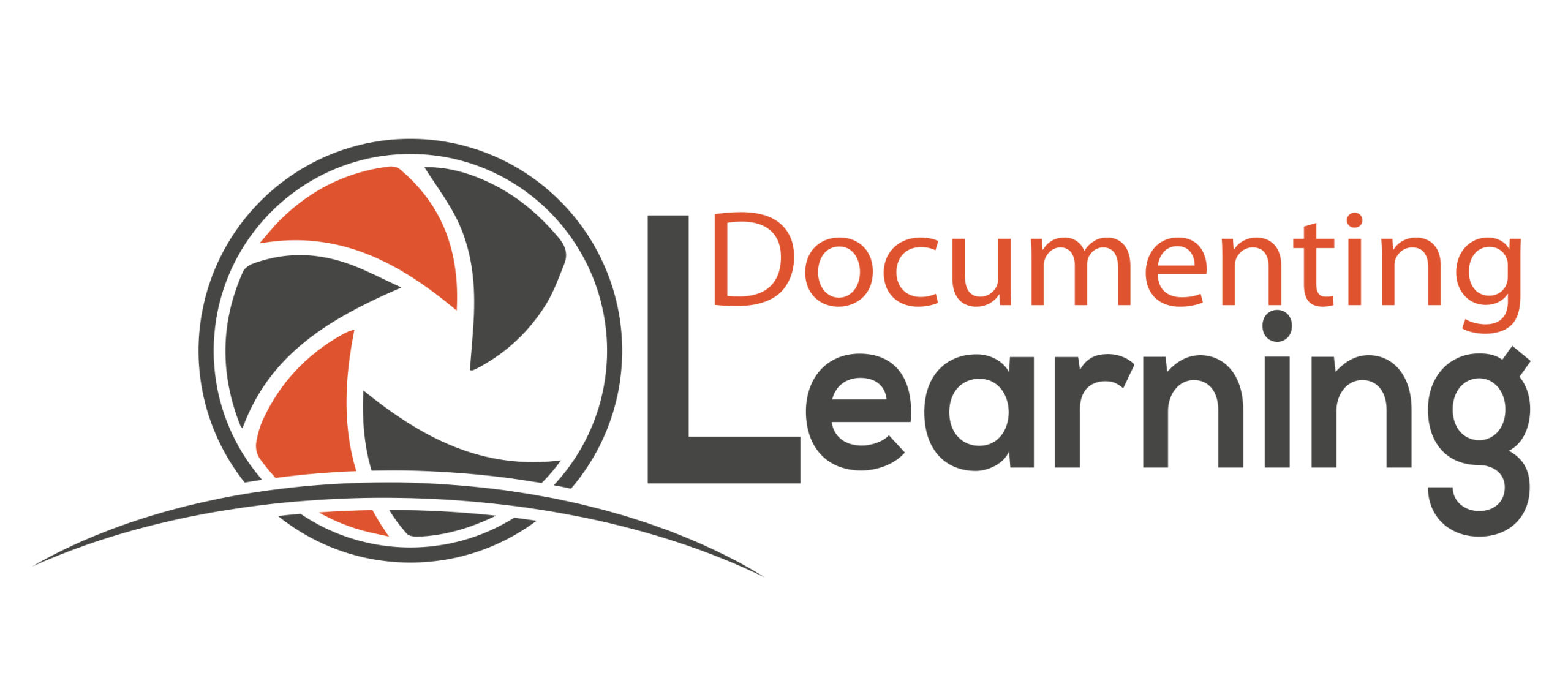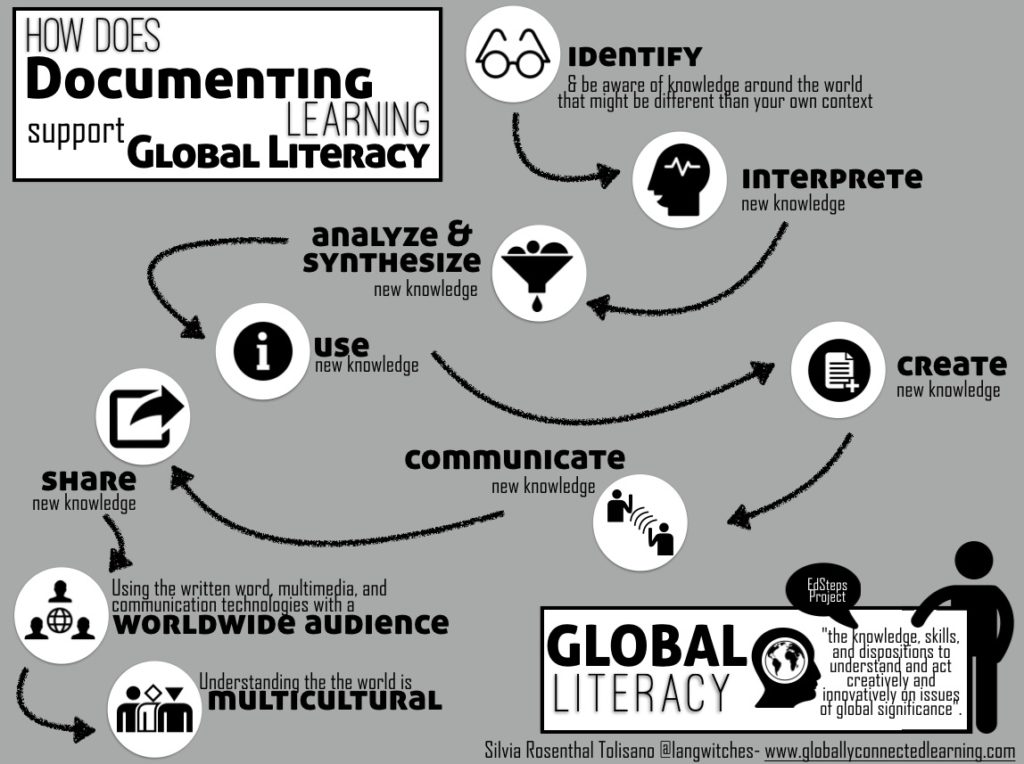 This is the fourth post in a series to dig deeper into the relationship between literacy and documenting learning. HOW does documenting learning have an effects on awareness, skills and developing habits around the so called 21st century “Now” literacies.
This is the fourth post in a series to dig deeper into the relationship between literacy and documenting learning. HOW does documenting learning have an effects on awareness, skills and developing habits around the so called 21st century “Now” literacies.
- Basic Literacy and Documenting Learning
- Media Literacy / Visual Literacy and Documenting Learning
- Digital Citizenship and Documenting Learning
- Global Literacy and Documenting Learning
- Information Literacy and Documenting Learning
- Network Literacy and Documenting Learning
Edsteps and the Asia Society define Global Competence as
The knowledge, skills and disposition to understand and act creatively and innovatively on issues of global significance.
Identify and being aware of knowledge around the world which might be different than your own context of knowledge
As we document our own learning environment, beliefs, practices, strategies, perspectives theories and learning process and we make them visible, we automatically identify them as existent. Sometimes this identification of our own cultural uniquness does not even occur, until we engage with the strategic purpose of documenting and the prospect of sharing with a global audience. If our own cultural identity and its characteristics are not on our radar, we most likely are not aware that it influences our decisions and practices and might only be one of many perspectives from around the world. The ability of standing back from ourselves and becoming aware of our cultural values, beliefs and perceptions in terms of learning, will give us the opportunity to compare and contrast them with others. Identifying and reflecting on what is uniquely a product of our cultural learning background is crucial to being aware of the relationship with it to others. A strategic component of documentation in terms of global awareness, is to identify specific evidence and artifacts that make our cultural point of view in terms of learning visible to others.
Interpret new knowledge
Learning about other cultures and the “way they do things”, supports the understanding of our own practices. When we learn from documentation of others, we do not only take advantage of their interpretation of learning artifacts and the learning process, we add our own interpretation of what we see, read and hear to the artifacts. We automatically use our background knowledge to interpret this new way of looking at learning. This interpretation of someone else’s documentation will have an effect on how we view our own practices and the realization that there is more than one way of doing something. We develop a deeper understanding of our own practices when we take the time to interpret documentation from around the word.
Analyze and synthesize new knowledge
Analyzing can be defined as to examine something critically, methodically and in detail to bring out the essential elements and for purposes of explanation and interpretation. Documentation for learning gives us the opportunity to do exactly that. We go beyond simply displaying of what was done, but examine in detail nuances, patterns, trends and implications for future teaching and learning. Synthesizing is about combining a variety of things to create something new. Learning from documentation in education from around the world allows us to combine different perspectives, activities, resources to expand our own repertoire of pedagogies, techniques and methods as well as learning strategies. We learn to extend our limitations of knowledge and to take advantage of global contributors to remix information or complement or contrast our own perspective and knowledge with theirs
Use and create new knowledge
By learning through documentation about theories, practices and resources from around the world, we find new ways of thinking and new ways of approaching our own problems. The better the documentation in terms of details, interpretation and significance of learning, the easier for the reader/listeners/viewer to be encouraged to use these new perspectives, approaches, ideas, concepts or information in their own learning and teaching practices. As we document, let’s keep other learners in mind who might want to follow in our footsteps and not re-invent the wheel by taking advantage of our experiences, theories, interpretation, conclusions, successes and falitures. Part of the amplification of traditional literacies is the opportunity to extent our ability to not only read information as a consumer, but also the ability to create new types of information. Documenting our learning and the learning of others gives us the opportunity to produce new information that give evidence of newly found knowledge. One way of demonstrating global literacy is by exhibiting the disposition to “understand and act creatively and innovatively on issues of global significance.” Documentation of/for/as learning can be such evidence of understanding and acting upon these issues.
Communicate knowledge
How do we want others from around the world to see us? It is common that one sees the things we do on a regular basis as common, nothing special and possibly even boring. When we document our work and our learning, then open ourselves up for feedback, we are often surprised that our audience can learn from us, finds our work interesting and they never could have thought of doing it in “your way”. They call you innovative and a thought leader. Derek Sivers called that phenomenon “Obvious to You, Amazing to Others” in his short video clip of the same title. Documenting learning helps us formulate and articulate not only WHAT we want others to know about us, but also encourages the documenter to make critical decisions of HOW to communicate our knowledge. Decisions about media types (text, audio, video, images) as well as platforms to reach a global audience must be made.
Share knowledge
When we share our documentation, our artifacts, interpretation, experiences and theories of learning, we allow others to give us feedback and test their theories against ours. That type of sharing supports action research and leads to innovation. By sharing across the globe, as opposed to with local classmates or colleagues, we amplify the degree of learning opportunities, remixes and allow others to build upon our knowledge. Problems od global significance will not be solved by the “lone wolf”, but by global teams. Sharing our knowledge with others is imperative. Traditionally, due to the lack of technologies to share easily, fast and economically, sharing of knowledge was limited and in the hands of book publishers, newspapers, magazines, radio and television. These barriers have been removed by the accessibility to publishing devices and networking platforms with the ability to reach millions of people around the world. Unfortunately, our mindset around sharing has not caught up with the ability and possibilities of doing so. We can’t learn from and with the world, if no one steps up to share with the world. The imperative of sharing as an educator and learner is becoming more and more apparent as we want to take advantage of crowdsourcing and ability of learning from and with the world and not merely about the world.
 Using the written word, multimedia, and communication technologies with a worldwide audience
Using the written word, multimedia, and communication technologies with a worldwide audience
In documentation, Reggio Emilia type, sharing documentation of learning rarely goes beyond the classroom to share with families and colleagues. With this “very” local approach, we miss important amplification of learning. When we use different technologies to document, we not to use technology for technology sake, but in order to be able to extend our reach in communicating our ideas, thoughts, theories and learning processes effectively.
 Understanding that the world is multicultural
Understanding that the world is multicultural
As we document our learning from our cultural perspective and perception and make this documentation available for a global audience, we add our piece to a puzzle that paints a picture of not just our corner of the world with its history, values, and point of view, but a picture that has many different puzzle pieces and demonstrates our diverse and multicultural word. If no one were to document and share their puzzle piece, we would not have the opportunity to view the “bigger picture” and grasp the immensity of human learning.










